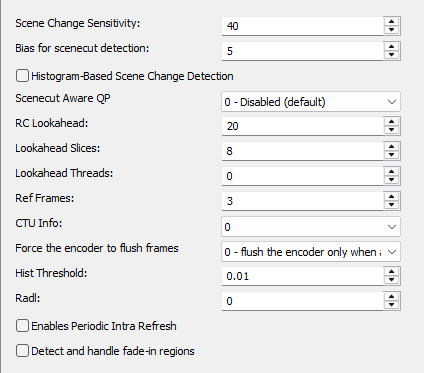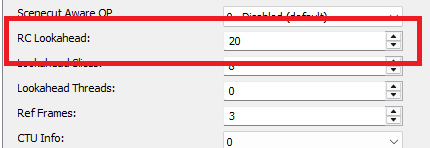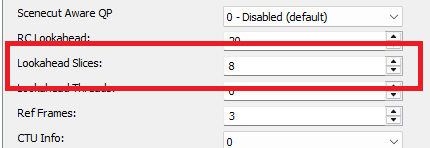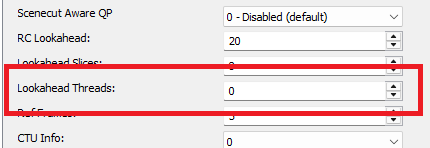H.265 - Codec: Slice Decision Settings

Scene Change Sensitivity
How aggressively I-frames need to be inserted.
The higher the threshold value, the more aggressive the I-frame placement.
Default 40

Bias for scenecut detection
This value represents the percentage difference between the inter cost and intra cost of a frame used in scenecut detection. For example, a value of 5 indicates, if the inter cost of a frame is greater than or equal to 95 percent of the intra cost of the frame, then detect this frame as scenecut. Values between 5 and 15 are recommended.
Default 5.

Advertisement
RC Lookahead
Number of frames for slice-type decision lookahead (a key determining factor for encoder latency).
The longer the lookahead buffer the more accurate scenecut decisions will be, and the more effective cuTree will be at improving adaptive quant.
Having a lookahead larger than the max keyframe interval is not helpful.
Default 20

Lookahead Slices
Use multiple worker threads to measure the estimated cost of each frame within the lookahead.
The frame is divided into the specified number of slices, and one-thread is launched per slice.

Lookahead Threads
Use multiple worker threads dedicated to doing only lookahead instead of sharing the worker threads with frame Encoders.
A dedicated lookahead threadpool is created with the specified number of worker threads.

CTU Info
This value enables receiving CTU information asynchronously and determine reaction to the CTU information.
- 1: force the partitions if CTU information is present.
- 2: functionality of (1) and reduce qp if CTU information has changed.
- 4: functionality of (1) and force Inter modes when CTU Information has changed, merge/skip otherwise.
Enables Periodic Intra Refresh
Enables Periodic Intra Refresh(PIR) instead of keyframe insertion.
PIR can replace keyframes by inserting a column of intra blocks in non-keyframes, that move across the video from one side to the other and thereby refresh the image but over a period of multiple frames instead of a single keyframe.
